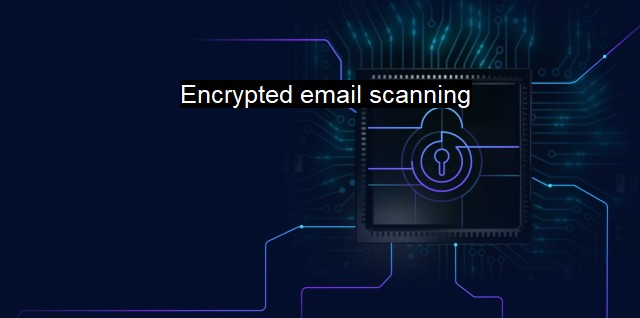What is Encrypted email scanning?
Protecting Against Malicious Content: The Importance of Encrypted Email Scanning and Antivirus Solutions in Cybersecurity
Encrypted email scanning is a cybersecurity measure employed by various anti-virus systems to safeguard email communications from prying eyes, such as hackers or malicious software. It is a protective measure designed to scan the contents of encrypted emails for any potential cyber threats by decoding them before conducting the examination.Email communications serve as bridges connecting individuals, institutions, businesses, and governments worldwide. Unfortunately, this also makes them ideal channels for cybercriminals to disseminate malware or unauthorized intrusion attempts. Encryption provides a way to mitigate these risks by ensuring only the authorized recipient can decipher the email content. malicious actors can exploit encryption systems to hide their malicious activities, making encrypted email scanning a crucial security element.
By definition, encrypted email scanning involves decoding an encrypted email, scanning it for malicious attachments or content, and then re-encrypting it for a secure transition. A typical email encryption system uses a pair of keys—public and private—to encrypt and decrypt the content. The sender encodes the email using the recipient's public key, which only the corresponding private key can decode. This process renders unauthorized access to the content virtually impossible; effectively securing the email content against unwanted intrusions.
As encryption can also shield malware-laden emails, encrypted email scanning plays a pivotal role in the cybersecurity ecosystem. Although email encryption secures messages, it can unwittingly provide cover for cyber threats to escape detection by standard antivirus systems. By implementing encrypted email scanning, businesses and individuals thus minimize the probability of falling victim to such insidious attacks.
The process begins when an incoming or outgoing encrypted email meets a scanning solution. This solution then decrypts the email to read its content. Equipped with sophisticated algorithms, it analyzes the content for spam, phishing links, malicious attachments, or any other ill-intentioned activity. Following a successful scan, the email is re-encrypted and sent securely to the recipient, thereby ensuring both cybersecurity and confidentiality.
One of the exceptional benefits of encrypted email scanning is the ability to inspect deep-seated or hidden threats inside encrypted content, including viruses, worms, ransomware, and other harmful payloads. The scanning software picks out tell-tale signs of cyber threats through pattern recognition, vulnerability analysis, and heuristic evaluation. Also, several systems employ artificial intelligence and machine learning procedures to enhance the accuracy and efficiency of threat detection.
Though significantly valuable, encrypted email scanning is not without challenges. Firstly, the deciphering process could momentarily expose the email content to threats. Thus, the scanning must be performed in a secure environment using trustable encryption techniques. Secondly, constant updates and patches are needed to keep up with evolving malware strategies. Lastly, it is also possible for the system itself to become a target, pressing the need for robust security infrastructure.
Privacy issues also present a complex challenge. Whilst the decryption is mandatory for scanning an email, users might express concern about the exposure of their sensitive information. Herein lies the task of striking a balance between protection and privacy.
The future of encrypted email scanning will likely lean heavily into artificial intelligence and machine learning. These technologies are rapidly improving the ability to identify new and emerging threats within encrypted emails, reducing false positives, and enabling faster response times. Ensuring private, secure, unimpeded email communication will continue to fuel advancements in encrypted email scanning technology—which is undeniably an essential tool and a dynamic field in cybersecurity.
In sum, encrypted email scanning is a powerful tool that provides an additional security layer in protecting email communications from various cyber threats. It cleverly demonstrates the power of combining encryption with antivirus systems for enhanced cybersecurity. As threat landscapes continue to evolve, encrypted email scanning remains a potent method for staying ahead of potential threats to the digital ecosystem. Therefore, organizations should consider it as a significant element of their cybersecurity planning and strategy.

Encrypted email scanning FAQs
What is encrypted email scanning?
Encrypted email scanning is a security measure that involves analyzing and identifying malicious content or attachments within encrypted emails. This is done without compromising the privacy and confidentiality of the encrypted email.Why is encrypted email scanning important in cybersecurity?
Encrypted email scanning is important in cybersecurity as it helps to prevent cyber threats such as malware, viruses, and phishing attacks. It allows organizations to detect and eliminate threats that may be hidden within encrypted emails, thereby protecting their systems and data.How does encrypted email scanning work?
Encrypted email scanning works by decrypting the email, scanning it for malicious content or attachments, and then re-encrypting it to maintain its privacy and confidentiality. It may also involve the use of advanced algorithms and machine learning to identify new and emerging threats.What are the benefits of using encrypted email scanning?
The benefits of using encrypted email scanning include enhanced cybersecurity, improved threat detection and response, protection of sensitive data, and compliance with industry regulations. Encrypted email scanning is an effective way to safeguard organizations against cyber threats and ensure the secure exchange of information.| | A | | | B | | | C | | | D | | | E | | | F | | | G | | | H | | | I | | | J | | | K | | | L | | | M | |
| | N | | | O | | | P | | | Q | | | R | | | S | | | T | | | U | | | V | | | W | | | X | | | Y | | | Z | |
| | 1 | | | 2 | | | 3 | | | 4 | | | 7 | | | 8 | | |||||||